In 1520 A.D., the Spanish conqueror Hernan Cortes tried to burn the Aztecs off the face of the earth. The Spanish genocidal fires destroyed thousands of books, manuscripts, religious talisman and artifacts. The Aztec people figuratively, and literally, burned along with them. Only five (5) illustrated pre-Columbian manuscripts (called codexes) survived. The Aztec God images above comes from the Codex Borgia. The Aztec image on the home page of this website is from the Codex Borbonicus.
Welcome to the Aztec God of the Month Club!
IMPORTANT WARRANTY: This article is way too long. This writing is a long, windy introduction to this twelve part series on Aztec Gods. This intro piece is wordy BUT once this background stuff is out of the way, everything else is streamlined. Each monthly God installment will be short and sweet. All members will get a little monthly note on some new Aztec God — just the juicy highlights of their life and times. The monthly goal is to get a chuckle, give some insight, and put a little bounce in your step. People who want the deep background on Aztec life and culture, keep reading. For those who want to get to the good stuff, just skip forward to Part II of this article — Bring on the Gods!
Part I – Okay, Why Would I Want to Join This Club?
What’s in it for Me?
November, 2022. As a Club member, you too can live like an Aztec God; or, at least learn the wisdom of the Aztec universe. Monthly, all Club members receive a fresh, new Aztec God delivered to their internet mailbox. This twelve month series starts with Coatlicue, the serpent-skirted Mother of all Gods. The final installment is Tlazolteotl, the Goddess of Filth and the “Patron Saint” of Adulterers. But why is this Club focused on the Aztec Gods? Because nothing is as soul satisfying — and at the same time as blood curdling — as Aztec World. Aztec cosmology is filled with many “say what?” moments. The actions of the Gods range from the most beautiful to doing the most beautifully insane things possible. These tales leave the reader with deep wonder about the beauty of our universe; the meaning of worldly existence; or just make obvious the grinding nightmare of our daily life.
We can give you some Aztec highlights. Let’s start off light — for example, the God who gave birth to himself (self-birthing – how does that work?) This God embodies all dualities. Later, he was able to serve as both “husband and wife” and gave birth to his (her?) own children; and again, how does that work? Aztec stories can also turn grim when, for example, one enraged God decapitated his Goddess sister. He then threw his sister’s head into the sky where it became the moon we see today. Or, we can share poignant Aztec moments like the mothers who die in childbirth have the same honor as Aztec warriors slain in battle. Warriors killed in battle, or mothers who die in childbirth, are rewarded by coming back as hummingbirds and butterflies. Think about that the next time a hummingbird flits by. The triumphs and tears of the Aztec deities offer many a life lesson and tale of morality. For example, the God of Temptation dared the God of War to get really drunk. The Temptation God then further challenged the War God to sleep with a celibate priestess. The War God took all the bait; and oh what a night! Upon awakening the next morning, the War God burned himself to death out of remorse. Such goes the life of the Aztec Gods.
The Aztec Gods Must be Crazy
The Aztec Gods have the wildest stories. Yet, what makes the Aztec cosmology fabulous is not just the occasional great story and life lesson. Looking at the big picture, the whole social fabric and indeed, the very neighborhoods where the Gods hang out; all of Aztec cosmology is just one big blood alley — the throat cutting, heart ripping, blood draining, human sacrifice, etc. All this bloodwork is needed to keep the world turning, and it is required by the Gods. But the best part is that death and blood sacrifice is a two way-street. The Gods are not immortal. They suffer and can die. Indeed the Gods can be sacrificed at the blood altar for the good of creation For an example of the Gods’ death through their blood sacrifice, see the story below of the Sun God Tonatiuh, our October centerfold. Two other Gods had to be sacrificed to create our current version of the Sun God.
As a result. the Aztecs owe human sacrifices back to the Gods to repay that blood debt. The Aztec Gods do it all. Aztec cosmology offers beauty, love, death, redemption and more: all in a river of blood and sacrifice by all — God and man. It just does not get any better than that.
This weirdness; or rather, the bittersweet charm, of Aztec cosmology is accentuated as many Gods have a dual aspect — a “good” and a “dark” side. They seem crazy as these Gods act out on both impulses doing bizarre things. An oversimplified explanation is that the Aztec’s sacred rituals, and daily life, all celebrate both “the good” and “the evil.” This good vs. evil dichotomy is the Western gloss on the Aztec reality. To the Aztecs, there is no big fight between Good in one corner and Evil over on the other side. Rather, all of the universe is a continuum of existence. Good and evil are mutually reinforcing manifestations of the One Truth. That does sound a bit thick. Maybe this explanation will help:
“At the heart of Aztec philosophy there exists “teotl” – a single, dynamic, vivifying, eternally self-generating and self-regenerating sacred power or energy. The real meaning of teotl is spirit — a concentration of power as a sacred and impersonal force. Teotl implies something more than the idea of the divine manifested in the form of a god or gods; instead it signifies the sacred in more general terms”Lightly edited for clarity from the Internet Encyclopedia of Philosopy. https://iep.utm.edu/aztec-philosophy/#SH2a
Westerners hold the world up to a candle and do what we do best: “pigeonhole.” We analyze, combine, reorganize, divide and shuffle everything into various categories — perhaps good and evil; or sacred and profane. Everything gets put in a plainly-marked, little desk slot, or perhaps assigned to some box. To the Aztecs, there are no boxes. All that is manifested in the universe is celebrated as sacred. With their understanding of teotl and the blessings of their Gods, Aztecs promote life, love, the continuity of the universe; and things like making more rain during the dry seasons. At the same time, the ancient Aztecs celebrated death, dying, ripping out human hearts, and just plain suffering; all of which show the veneration of God by man. It’s all good.
Two Important Notes on Human Sacrifice. Note 1.) Without a doubt, human sacrifice did exist among the ancient Aztecs. However, there is huge research and debate about the degree, and amount, and type of sacrificial victims. All that dying and death is attention-grabbing, but was human sacrifice that wide-spread? Perhaps the scope and scale of the blood sacrifice claims are exaggerated? The answer is unclear. Note 2.) Aztec culture and tradition is not dead. The direct descendant of the Aztecs, the Nahua, keep alive and practice Aztec traditions. However, the human sacrifice and other gory aspects of traditional Aztec culture are no longer practiced.
Presented below is a short resume of each major God showcased in this twelve-part series. Thus, this list is the menu that will be fleshed out in the Club offerings – one month, one God, one chilling story at a time.
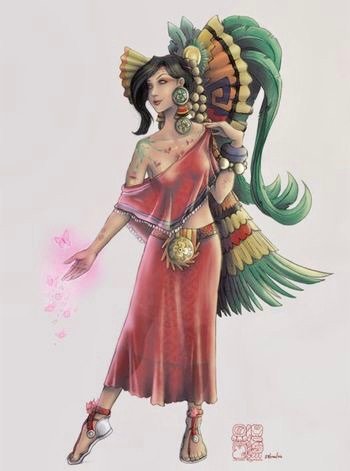
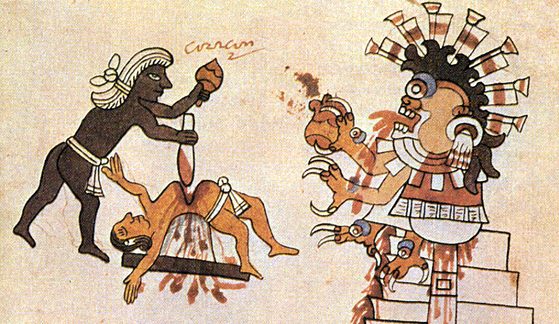
Shameless Plug: Aztec cosmology reflects daily life but in a grotesque way that shocks western thought. The delight and terror in Aztec cosmology has no equal. And you can enjoy it now at no cost. Plus at any time you can cancel your free subscription in the Aztec God of the Month Club. We offer a money back guarantee. Go to the home page and click the red “subscribe” button. You will automatically be enrolled in the Club. It’s that easy.
Subscribe
Preview of our First Installment: Goddess Coatlicue, the Mother of All
Coatlicue will be rolled out and delivered in December, 2022. This firecracker of a first installment is the story of Coatlicue, the snake-skirted mother who had four hundred and one (401) children. The first four hundred offspring decided to kill their mother for adultery as she became pregnant AGAIN. However, the Southern Four Hundred, as they were called, could not get past the youngest, child number 401. This last sibling was the omnipotent Huitzilopochtli, the God of War. At the moment the Southern Four Hundred attacked mom, Huitzilopochtli, burst forth from the womb fully formed. He was armed with a shield of eagle feathers, arrows and turquoise darts. Huitzilopochtli bravely fought and defeated all of the Southern Four Hundred. The survivors could only escape by fleeing to the far universe to become stars in the southern sky. The Goddess-rebel leader of the Southern Four Hundred was decapitated by Huitzilopochtli. In a rage, he heaved his sister’s head up into the sky where it became our moon. This outline has just some of the highlight of this amazing Goddess. The first installment for Club members will give you the entire inside scoop on Coatlicue. In Part II below, you can also find out more about Coatlicue, including a video of modern day Aztec descendants celebrating this Mother Goddess.
Their Powerful Gods Reflect the Might of the Emergent Aztec Empire
Ancient wisdom came from ancient civilizations. Many of these long-gone societies emerged from the distant sands of time — think of the Ancient Egyptians or Chinese civilizations. Other empires are much more “modern.” Many a civilization we consider “ancient” really only established their blazing empire a couple of hundred years — a handful of sand — before the Europeans came and conquered. Longstanding ancient empires, like Egypt, were in a slow decline for a millennium before they were destroyed. In 332 B.C.E., the Greek conqueror, Alexander the Great, marched into Egypt. He incorporated the remaining remnants of that civilization as a province of the sprawling Greco-Roman Empire. It was all over for the Egyptian Pharaoh. And all this happened 1,800 years before the Spanish flattened the Mexican Aztecs.
In contrast, the Aztecs were a new empire just emerging in their corner of the world when it was snuffed out and left for dead by European conquerors. The fearsome Aztecs Empire had humble beginnings. During the twelfth century A.D., the Aztecs (or Mexica as the tribe called itself) were a small and obscure tribe searching for a new homeland. In 1345, under the guidance of War God Huitzilopochtli, the Mexica settled near modern day Mexico City. Over time, the Mexica defeated the nearby Toltec tribes and many others, such as the Otomi and the Chichimecs. In only a few generations, the Mexicas, now known as Aztecs, built a huge empire in central and southern Mexico. At the beginning of the 1500’s, the Aztec capital, Tenochtitlan, was one of the world’s largest cities. The Aztecs ruled supreme in the 15th and 16th century. Then, Spanish conqeror Hernan Cortes arrived in the beginning of 16th century and all hell broke loose. Cortes arrived in 1519. By 1521, two years later, the death and destruction was complete.The glory of the Aztec Empire was over. The Roman Empire lasted one thousand years; the Aztec empire, less than two hundred.
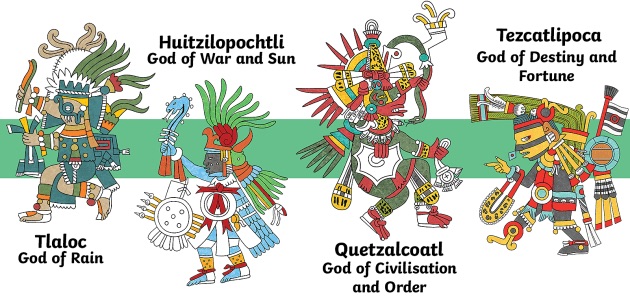
Part II – Bring on the Gods! The Aztec Top Twelve
A short outline of each of the major Aztec Gods is presented here. These offerings are the menu that will be fleshed out in our new series, the Aztec God of the Month. Every month, members will get a brief and concise description focused on one Aztec God. The article will serve as that God’s resume, highlighting his or her background and experiences.
December 2022 Month One — Coatlicue, the Mother of all Gods
A brief version of the life of Goddess Coatlicue is presented above in the “Preview of the First Installment”. Her lusty story is not relegated to some dusty anthropology textbook. The Aztecs of today, the Nahua tribe and others, still worship their Mother Goddess, Coatlique. Below is a video clip of traditional Aztec dancers, (Concheros) performing the Danza Coatlicue. For Club members, Coatlicue will roll out her life and story in our December 2022 offering. That’s right: Coatlicue is our first Aztec God of the Month. She is good to go in the first week of December; and will be delivered fresh to your email mailbox, all ready for your enjoyment.
The pictures below allow you to appreciate more about Coatlicue of the serpent skirt. She is represented by her skirt made of writhing, interwoven snakes alluding to fertility and drooping breasts that suggested her pregnant state. She had four hundred and one (401) children.
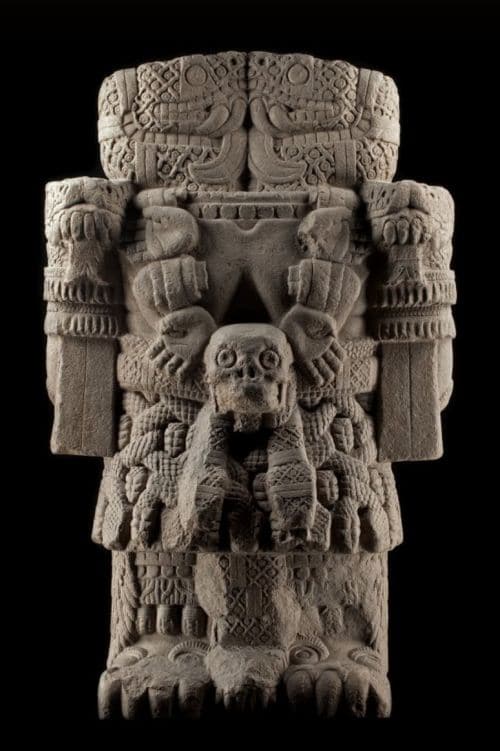
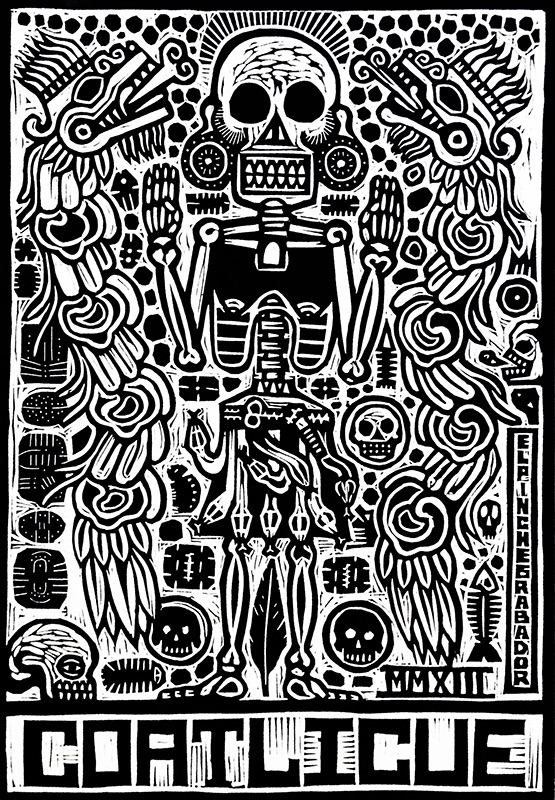
January 2023 Month Two – Ometecuhtli, the Two Lords Duality of the Universe
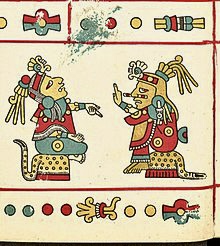
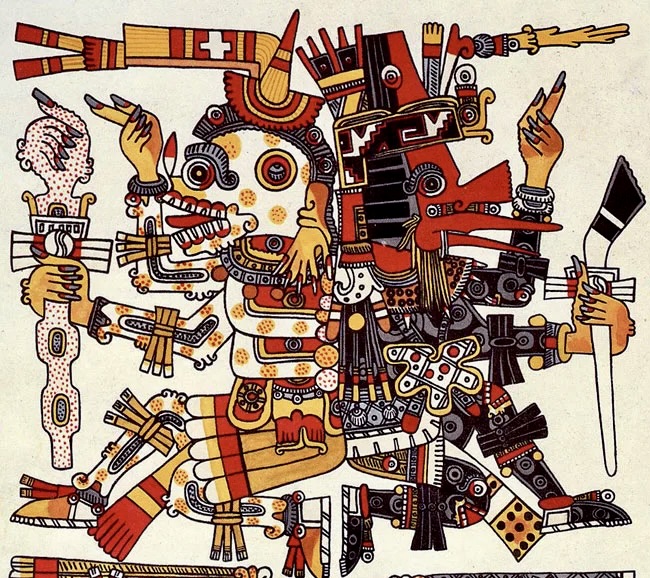
The Aztec pantheon, like most religions, has an apex God; the top-dog, primordial creator. The “king of the hill” is Ometecuhil, primordial divine being of fertility. Ometecuhil is a dual entity representing both male and female, but also and other dualities – light and dark, chaos and order, and of course, good and evil. Ometecuhil is thus, both the king and queen of the hill.
In the Aztec creation story, Ometecuhtlin gave birth of himself (self-birthed) but how that works is a mystery to this writer. This androgynous being’s dual genders allowed Ometecuhtlin to serve as both husband and wife in giving birth to four other major Aztec Gods – no outside intervention needed. Ometecuhtli currently resides in the 13th Heaven of Aztec cosmology. This highest plane of existence has removed Ometecuhil from the affairs of the lesser Gods and mere mortals.
February 2024 Month Three –Huitzilopochtli, God of War and Hummingbirds
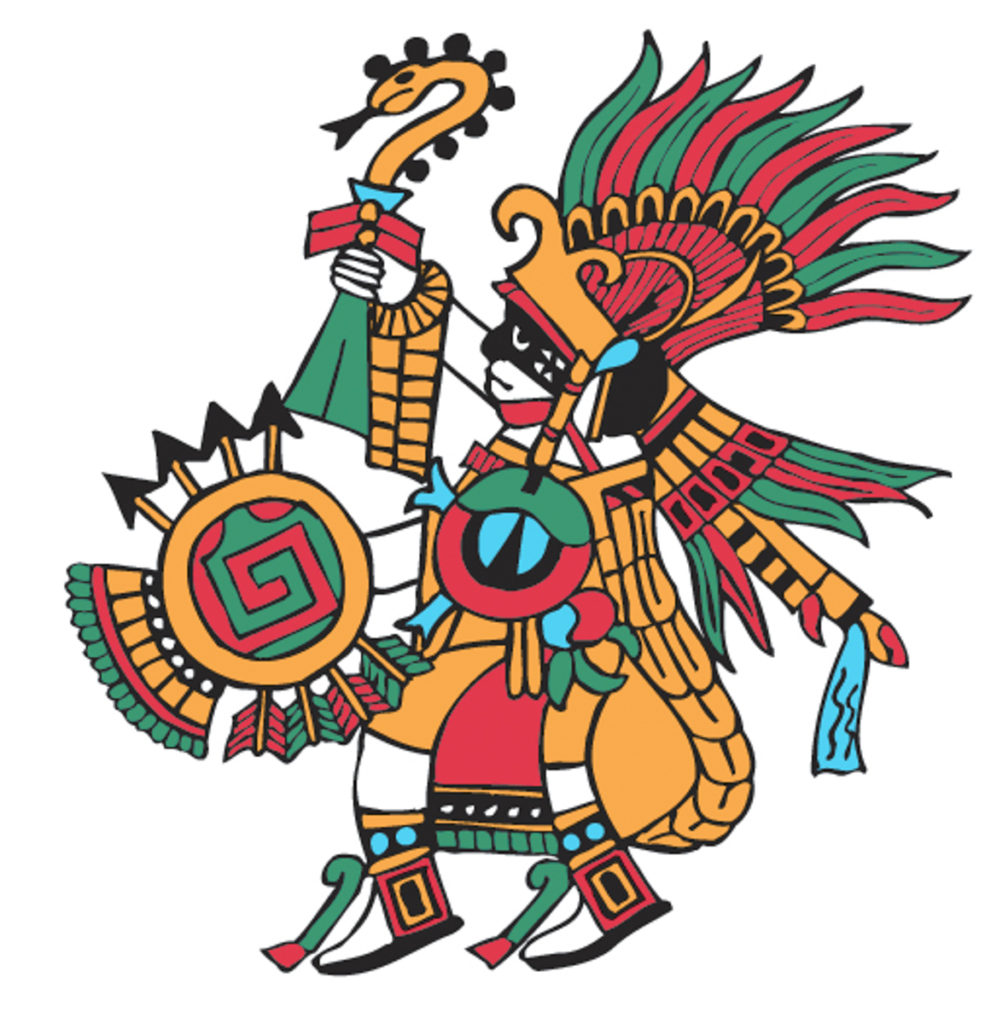
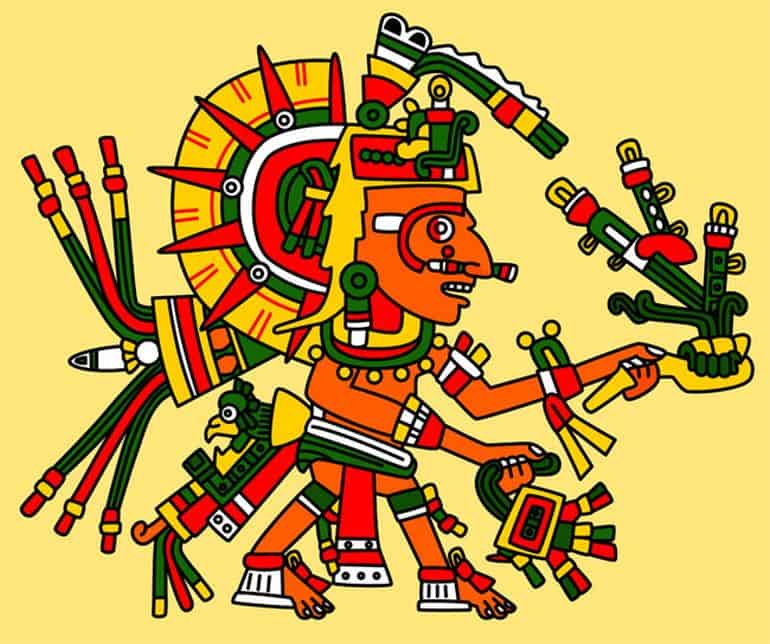
Huitzilopotchti is one of earliest Gods of the Mexica people. He is also the most powerful of the Gods and the most feared by the Aztecs. Huitzilopochtli, way back when, guided the Mexica safely to find their new home in Teotihucan, which became the springboard for their empire. Huitzilopochtli is called the Southern Hummingbird God as slain Aztec warriors are reincarnated as hummingbirds. Huitzilopochti ties together the ‘hunger’ of the Gods for blood with the penchant for ritual war ending in human sacrifice. He is the God of War, the sun and human sacrifice. He defended his mother Cuatlicue from the Southern Four Hundred, the marauding band of her children bent on matricide.
March 2023 Month Four-Xoloti, God of Fire and Lightening and the Evil Twin of Quetzalcoatl
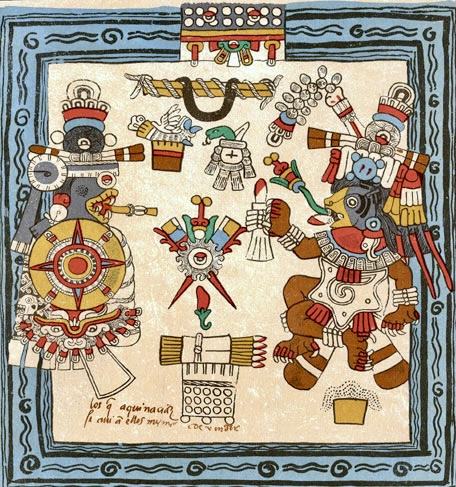
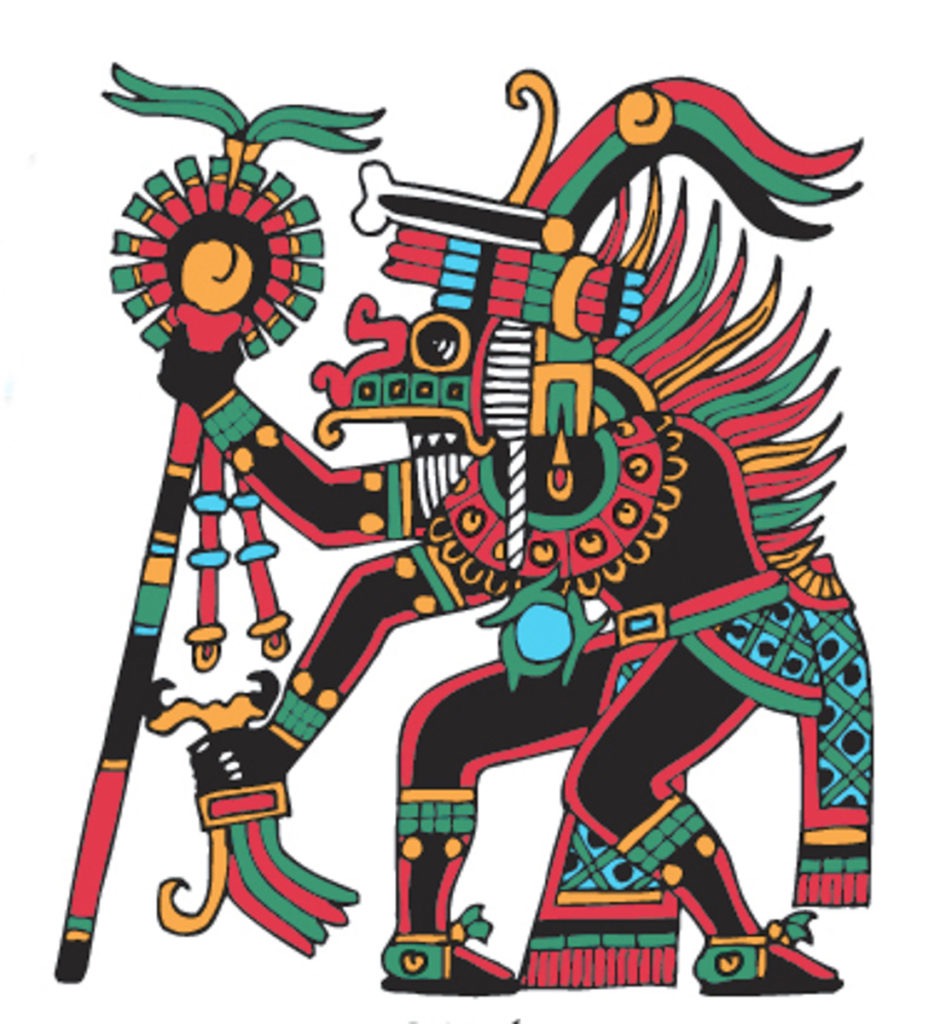
Xolotl is the God of fire and lightning. He is commonly pictured as a dog-headed man and was a soul-guide for the dead. He is also god of twins, monsters, misfortune, sickness, and deformities. Xolotl is the canine brother and evil twin of Quetzalcoatl. He is the dark personification of Venus, the evening star, and was associated with heavenly fire.
April 2023 Month Five — Quetzalcóatl, the Feathered Serpent
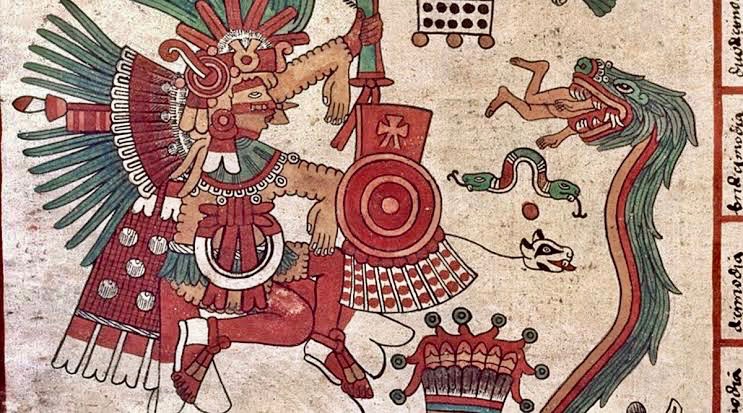
Above and Upper Right: Quetzalcóatl led the Mexica from their legendary homeland in the north, Aztlán, to the Valley of Mexico. There, he instructed the Mexica to find an eagle eating a snake. Once they spotted the eagle, the Mexicas built their capital, Tenochtitlán, on that site. Lower Right: The symbol of the eagle and the snake astride a cactus is now the national symbol of Mexico. The eagle and snake is proudly displayed on the Mexican flag
The name “Quetzalcóatl” can be translated as either the “Plumed Serpent” or the “Feathered Serpent.”
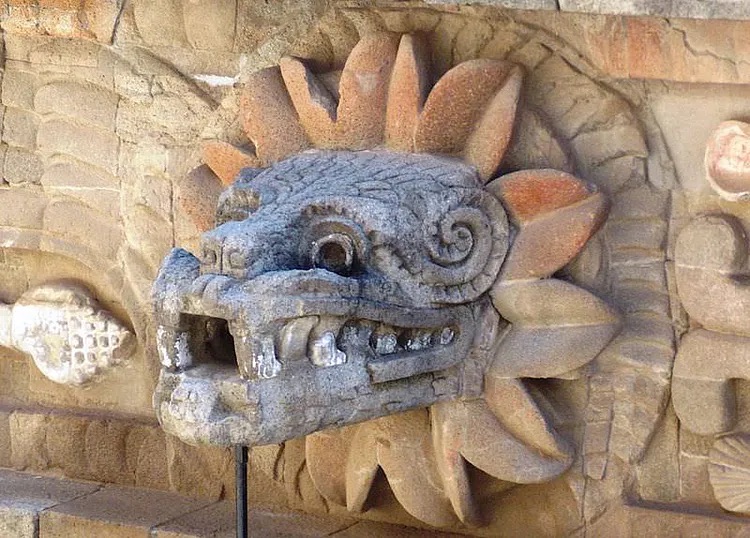
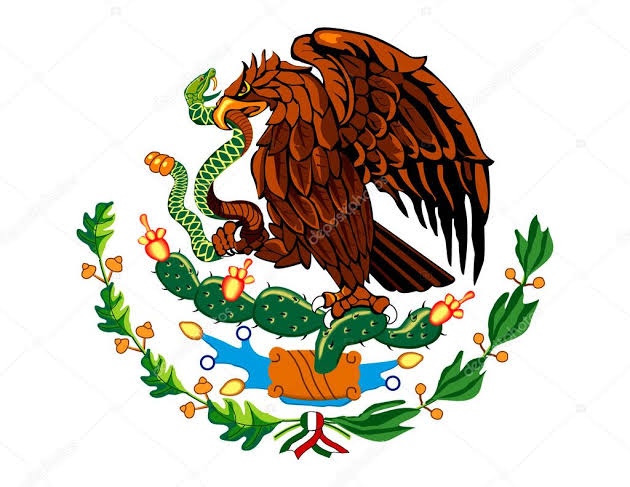
Quetzalcóatl is the four sons of the primordial God Ometecuhil. He is one of the top four Aztec gods as he created the earth and mankind. His name “Quetzalcóatl“ combines the Nahuatl words for the the emerald plumed bird (quetzal) and serpent (coatl). He is also the God of wind and rain. Quetzalcóatl also promotes a variety of human activities such as science, agriculture, crafts and even merchants.

In the Aztec creation story, the world was created and later destroyed and recreated four times. Each of these five ages are associated with a new sun. Some of the tumultuous events in the different stories of creating each new age are punctuated by the epic fighting between Quetzalcóatl and his brother Tezcatlipoca, (see below for this God.) Ultimately during the Fifth Sun, our current age, Quetzalcóatl succeeded in retrieving human bones from the underworld guarded by the realm’s ruler – Mictlantecuhtli, a God also set it below. The human bones were mixed with corn and Quetzalcóatl’s own blood to once again, regenerate mankind. Thus, modern humankind owe their very existence to Quetzalcóatl and repays him in blood sacrifices. In the first creation story, Quetzalcóatl along with his brother Tezcatlipoca, fashions the earth out of Cipactli, a female serpent-like monster. Consequently, her hair and skin give way to trees and flowers, while her eyes and nose account for the caverns and springs. However, given the violent loss of her physical form, the monster Cipactli (now embodying the earth) thirsts for blood and hearts – more human sacrifice. Again, these stories are examples of the duality of Godly blessings on earth.
May 2023 Month Six — Tezcatlipoca, the Smoking Mirror
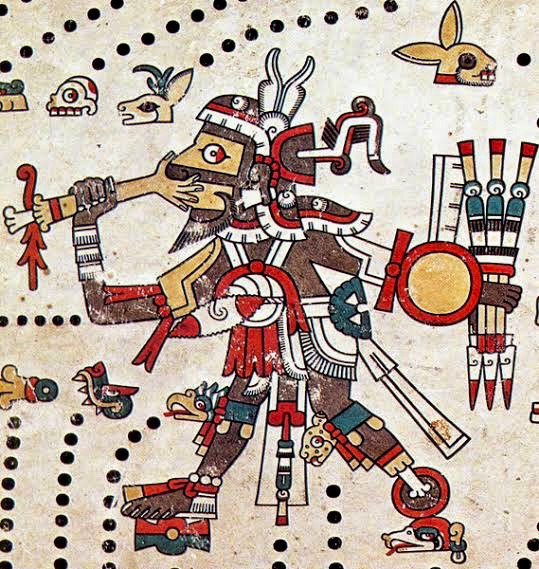
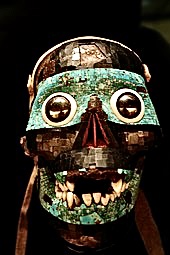
Tezcatlipoca is one of the top four Gods, as one of the four sons of Ometecuhtli. Tezcatlipoca Is associated with wildly divergent elements of the Aztec world: night sky and night winds, hurricanes, earth, obsidian, hatred and discord, divine rulership, sorcery, divination, beauty, war, and civil strife. And he is also the God of Temptation. Tezcatlipoca‘s name translates as “Smoking Mirror” as he is associated with obsidian; the glasslike volcanic rock polished up as mirrors. This Lord of the Nocturnal Sky is the eternal antithesis of his brother. Quetzalcóatl. However, both Gods are needed for the world to thrive. Tezcatlipoca working with his eternal opposite, Quetzalcóatl, created our world by subduing the Earth Monster, Cipactli, as set out in the above section on Quetzalcóatl. In that struggle, Tezcatlipoca lost his right foot when he used his leg as bait to capture Cipactli. Note: In the picture above left, Tezcatlipoca’s right leg looks like it has been replaced by some sort of prosthesis. And Tezcatlipoca, as the God of Temptation, tempted Quetzalcóatl to get drunk and sleep with the celibate priestess, discussed in the introduction to this article. As mentioned, that did not turn out well for Quetzalcóatl or for the priestess.
June 2023 Month Seven — Xipe Totec “Our Lord the Flayed One”
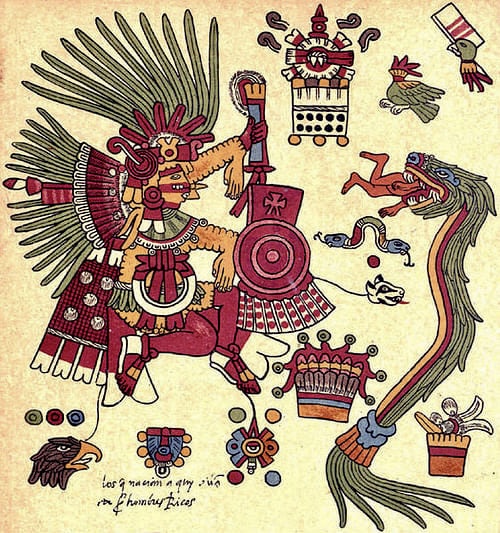
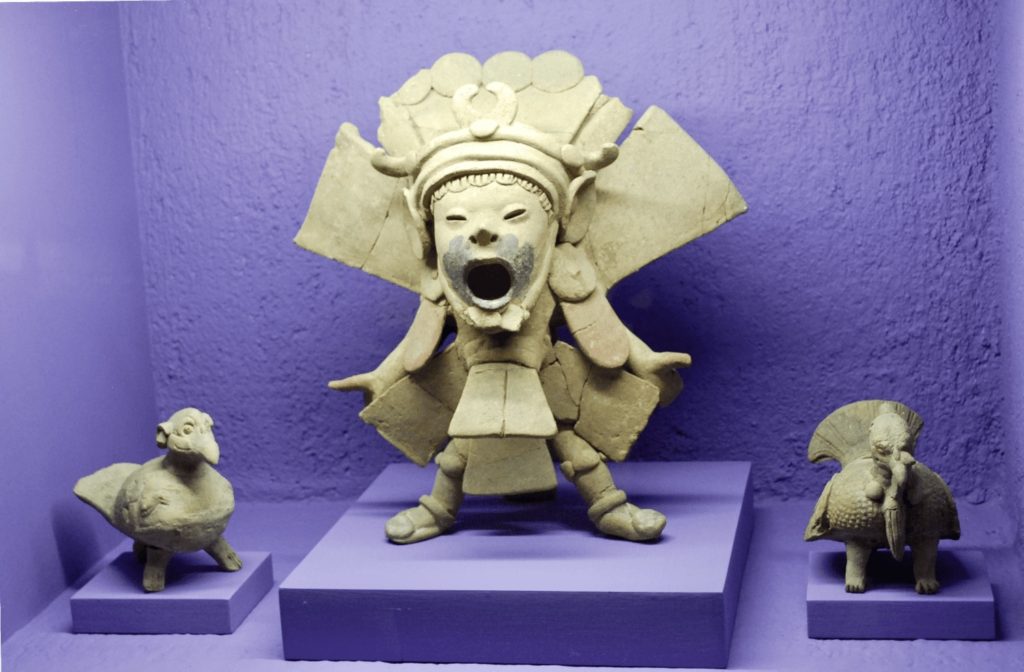
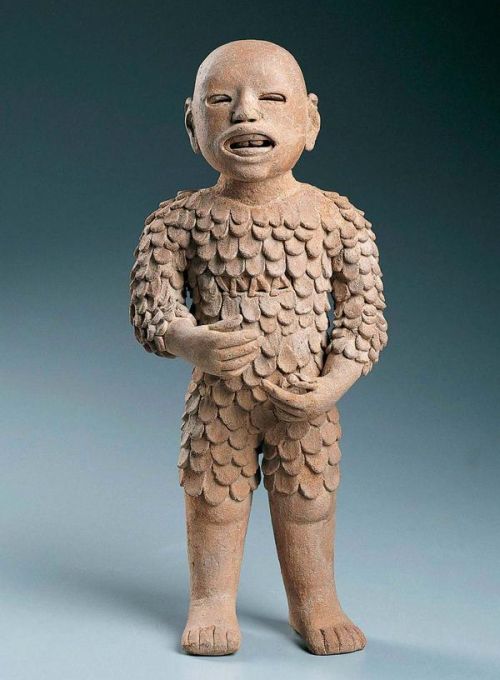
Xipe Totec translates to “Our Lord with the Flayed Skin.” [just in case: flayed means to cut off the skin from a human or animal body]. Early in Aztec history, this God flayed his own skin to feed humanity, thus symbolizing how corn (maize) sheds its outer skin cover before germination. Thus, it is easy to see how Xipe Totec became the central agricultural figure and also the center of a death cult. The Mexica people venerated Xipe Totec with human sacrifices to honor repay him for his sacrifice to save the people. These human sacrifices were mostly carried out during the March festival of Tlacaxipehualiztli (“the celebration of the flaying of men”.) Some of the human sacrifices were, yes indeed, flayed alive. Rest assured, this practice has been discontinued.
July 2023 Month Eight — Tláloc, Rain God “He Who Makes Things Sprout”
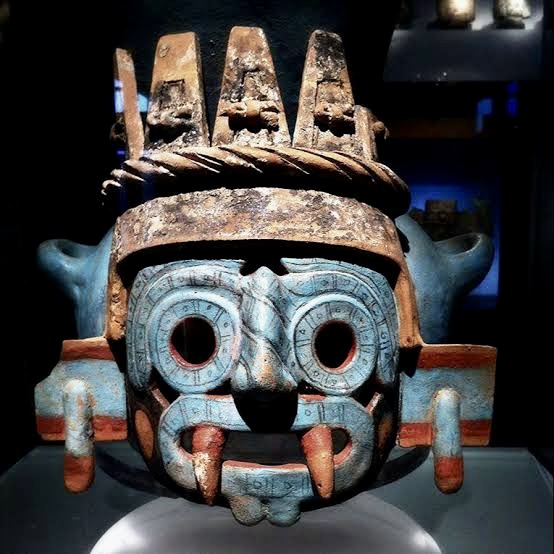
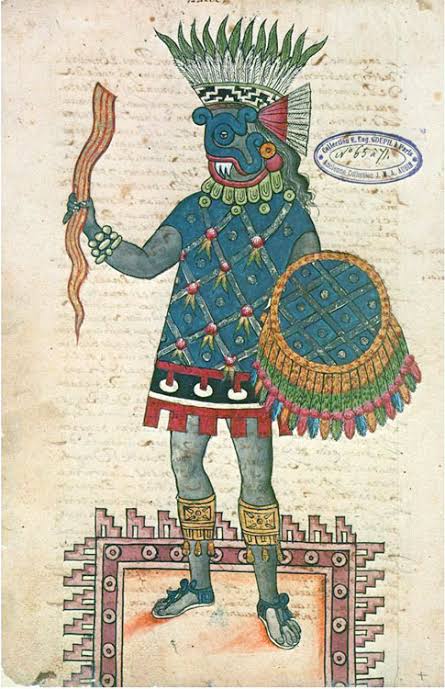
Tláloc, an overarching God, is the supreme deity of rain and related phenomena such as lightning flashes and hail. Tláloc provides life-giving water to people, animals, vegetation and most importantly, crops. Vegetables and other food will not grow without the rains. In his earliest representations, from circa 3rd to 8th century AD, Tláloc was a masked divinity with large round eyes and extending fangs. Later representations were much less foreboding. As a natural result of his rain making abilities, Tláloc is also the God of fertility, truly making him “He Who Makes Things Sprout.” This beneficent rain God also has a dual nature. Along with life affirming rain, Tláloc also brought forth scary thunder, hail, rainstorms, and hurricanes, all of which were attributed to killing people on occasion.
August 2023 Month Nine — Xochiquetzal The Goddess of Beauty and well…. Sex
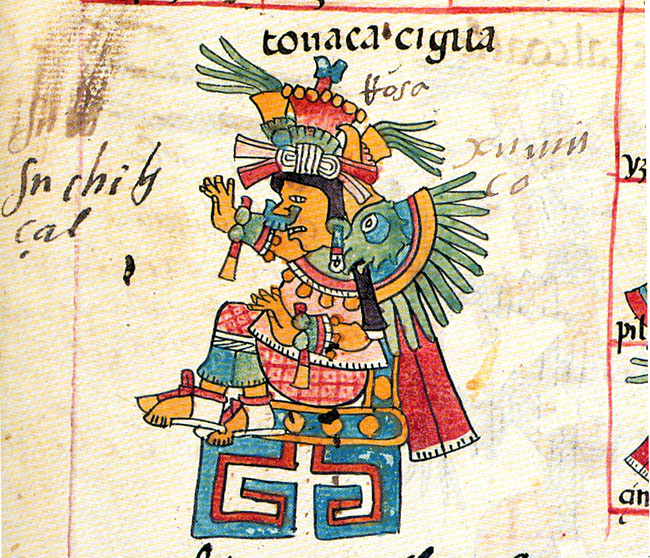
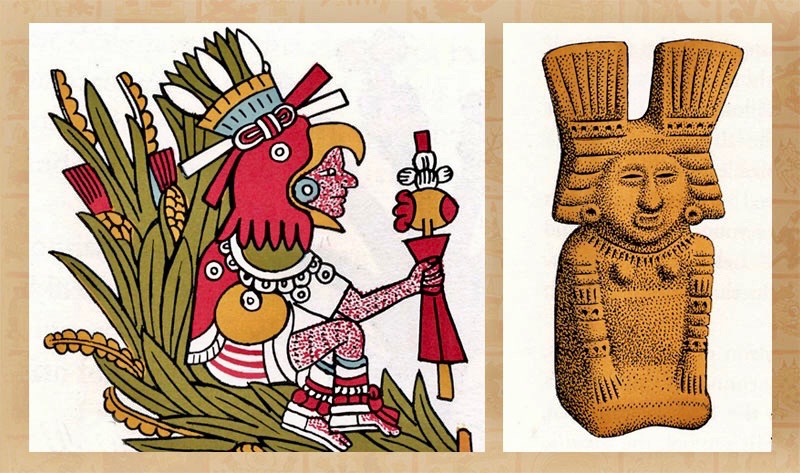
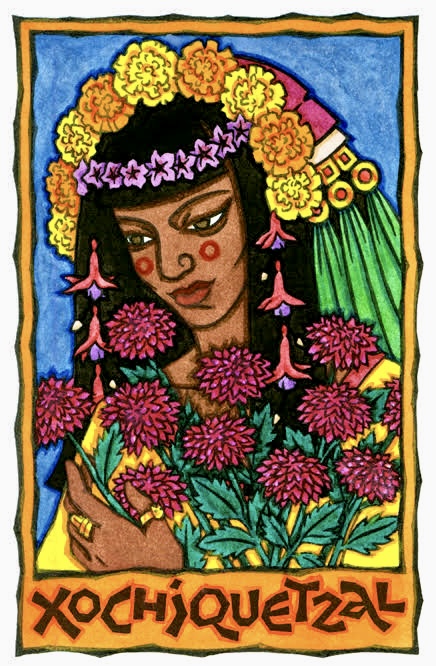
Although there are other Goddesses with a similar portfolio of responsibilities, Xochiquetzal ( ‘maiden’) is the Goddess who really empowers beauty, sexual love, pregnancy, and young mothers. She is also the patron of weaving and embroidery. She is an attractive, youthful woman in exquisite attire. Her outfit is commonly bedecked with flowers and followed by a vibrant retinue of birds and butterflies. Xochiquetzal has only a good side. Apparently, she has no “dark side”, as she is all milk and honey. Xochiquetzal was originally the wife of rain god Tláloc but was later abducted and forced to marry Tláloc’s sibling rival, Tezcatilpoca, the God of the Night.
September 2023 Month Ten — Mictlantecuhtli, “The Lord of the Dead”
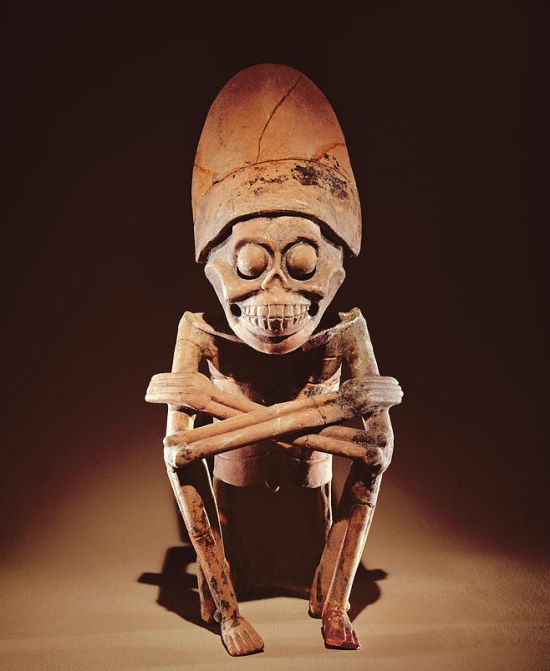
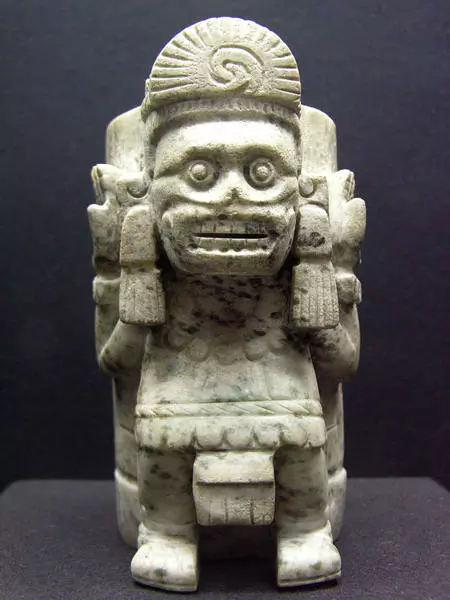
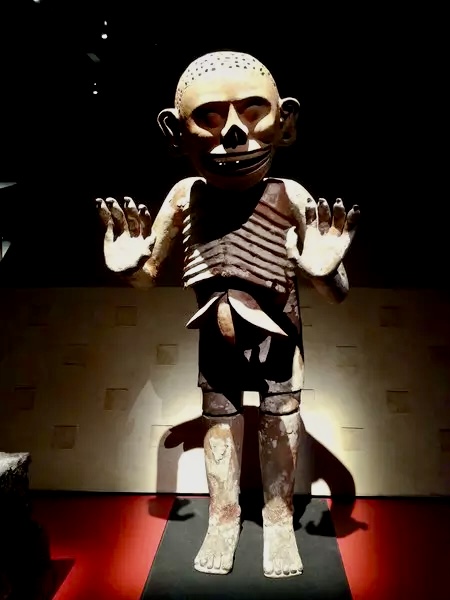
Mictlantecuhtli is the deity of death and the underworld. He is associated with creatures of the night – owls, spiders, and bats. Mictlantecuhtli was often represented as a skeletal figure with blood spots or an ominous entity wearing a skull mask and necklace of eyeballs.
After death, the human souls of both righteous and immoral people, that is, all souls must make the difficult four year journey to the deepest level of the underworld, where they face down Mictlantecuhtli. The souls eventually reached extinction in this deepest part, called Mictlan Opochcalocan, the lair of Mictlantecuhtli. The only souls exempt from this journey were from the people who died a violent death. The violent deaths would include slain warriors, women dying from childbirth, or deaths from natural disasters such as storms and floods.
Thus, the Aztecs did not believe in a special paradise reserved only for the righteous. All people shared the same destiny after death, both the wicked and the noble, except for the victims of violent death. Everybody who did not have a violent death would descend the nine layers of the underworld in an arduous four-year journey to Mictlan Opochcalocan, where the soul is eradicated from the universe. Note: there are other versions to this end-of-life story which have very strange, but very different, outcomes. These alternative endings of existence will be explored over the course of the Club offerings.
October 2023 Month Eleven — Tonatiuh, the Turquoise Lord
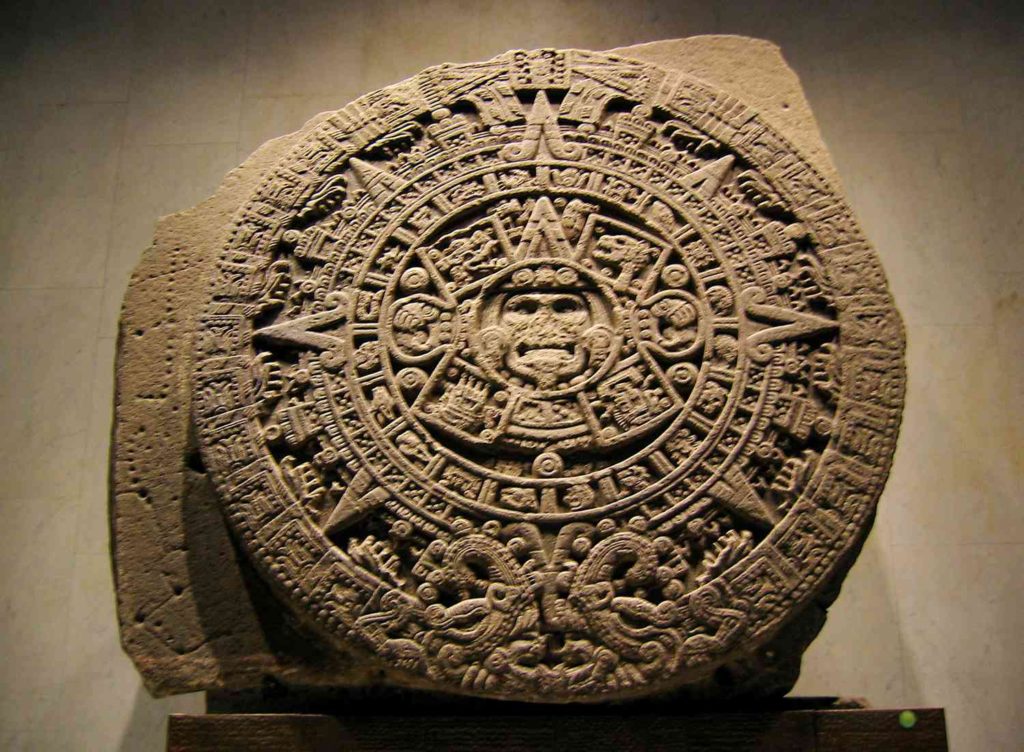
“After the fourth sun was destroyed, the Aztec gods gathered together to create the fifth and final sun: Tonatiuh. Like the suns that preceded him, Tonatiuh was not immortal. Upon his death, the world would descend into permanent darkness and the reign of men would come to an end. To create a new sun to return light to world, and it was decided that two Gods, both Tecciztecatel and Nanahuatzin would be sacrificed to bring the new sun into existence. Both of the gods prepared for their sacrifice by fasting for four days. Tecciztecatel’s preparations were extravagant:
‘His ritual branches were of quetzal feathers, His grass heart was woven of gold. His bloodletting spine needle was of greenstone [likely jade], …The actual bloodletting tool was a blood-covered instrument made of coral.’ [Cite omitted]
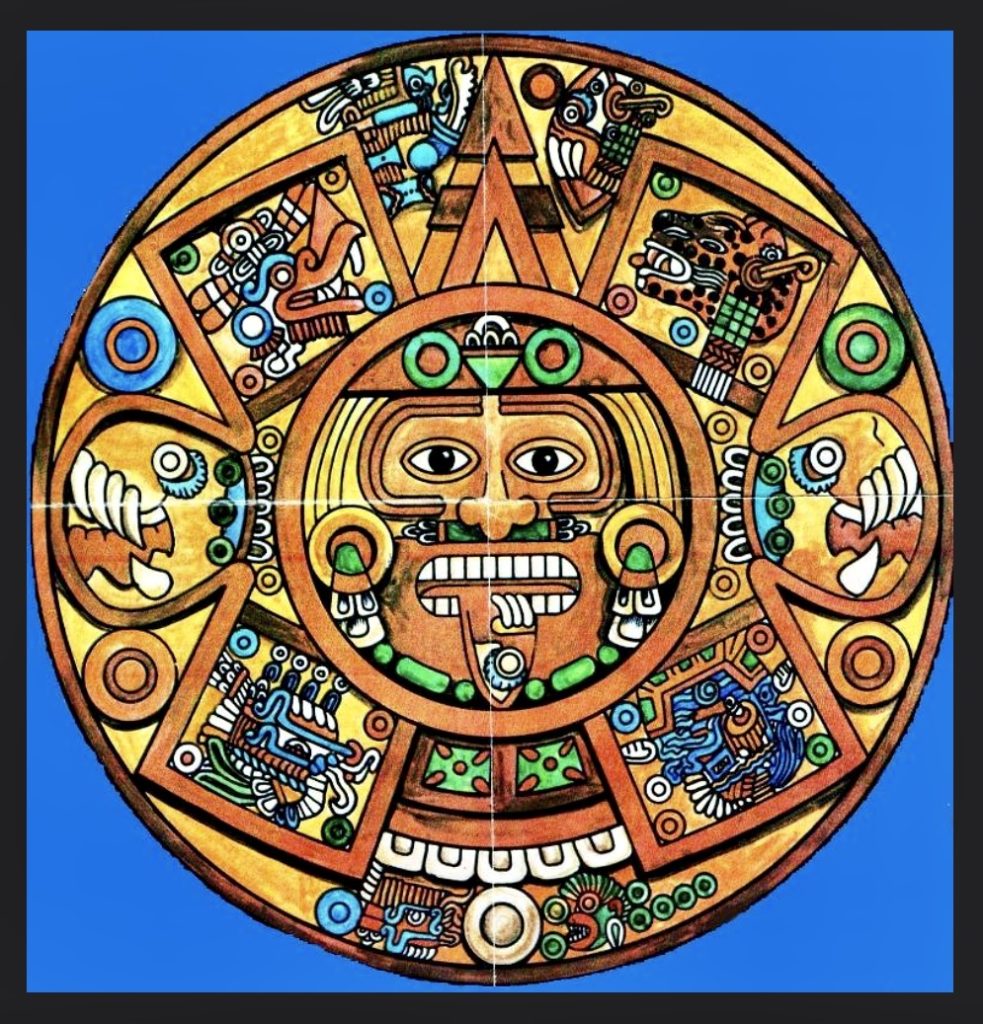
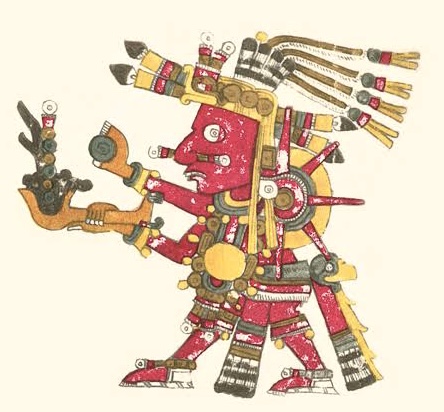
The name Tonatiuh means “Movement of the Sun”. Tonatiuh is the Aztec sun deity and God of the daytime sky. He also represents warmth, life, and fertility because of the life-giving power of the Sun. To keep Tonatiuh satisfied, heart sacrifices were made so that the Sun would continue to. make its journey across the sky. The very movement of the sun required the blood and hearts of humans.
November 2023 Month Twelve — Tlazoltéotl, Goddess of Filth
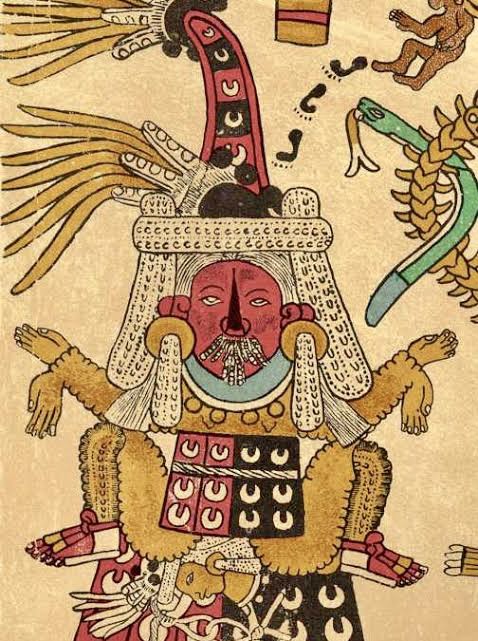

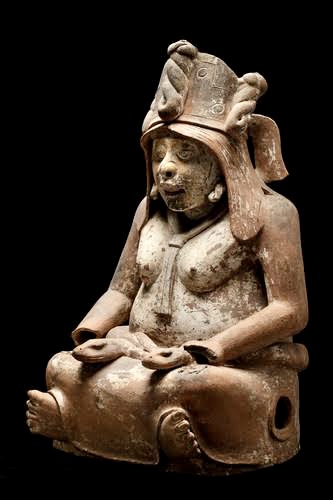
Tlazoltéotl, (Nahuatl: “Filth Deity”) is a complex Earth Mother Goddess. Tlazoltéotl is the Goddess of Dirt, literally and figuratively. She is the Aztec Goddess who represents sexual impurity and sinful behaviour. Tlazolteotl is the deity of vice, purification, steam baths, lust, filth, and the patron saint of adulterers. She is also the Diety of Dirt. Tlazoltéotl is in charge of the the black, fertile earth; the rotting earth; the fecund earth that gains its energy from death; and this earth in turn, feeds life. Thus, she is called an “excrement eater” and that is not a potty mouth insult (good luck foreign readers), but recognition of good, sustainable earth husbandry. Associated with purification, expiation, and regeneration; Tlazoltéotl turns all garbage, whether physical or meta-physical, into rich life.
Shameless Plug. Please consider signing up for a FREE subscription to this website which is both a travelogue and literary journal. Notices of new postings, about three new articles a month, will be sent to your email inbox. Note: Your information will never be marketed, sold, or used in any way. The marketing of personal data is a horrible idea.
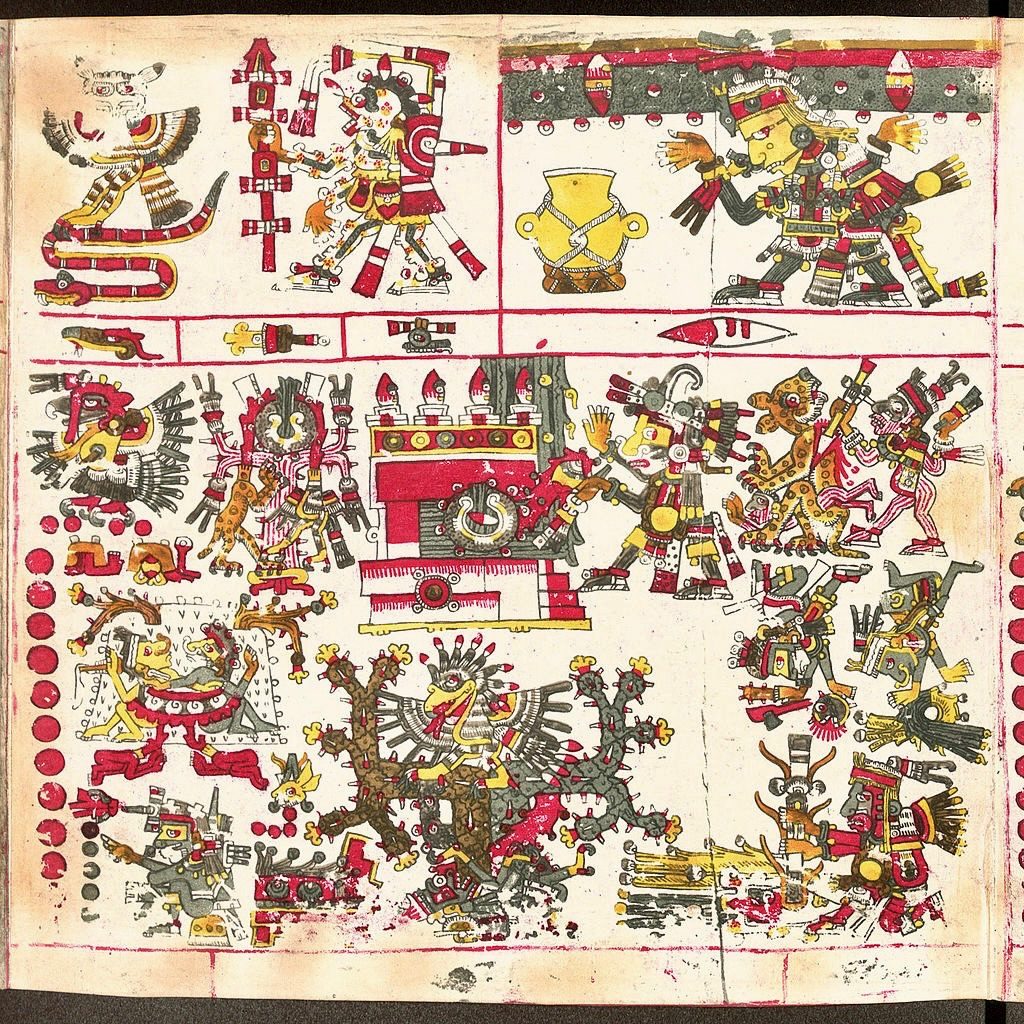
Pingback: Aztec God of the Month No. 1 Coatlicue — The Earth Goddess From Womb To Tomb – Temples, Textiles and Tribes